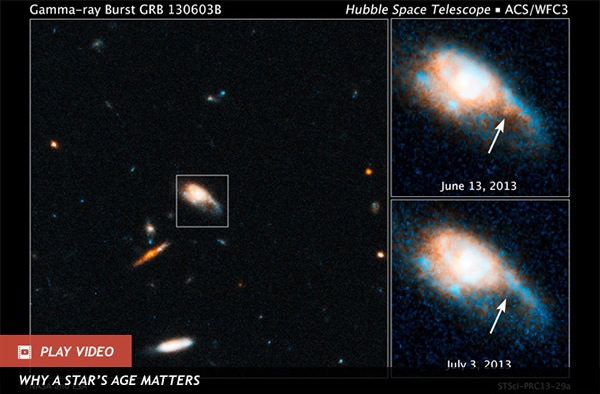Kilonova Alert! Hubble Solves Gamma Ray Burst Mystery
Kilonova Alert! Hubble Solves Gamma Ray Burst Mystery
Gamma ray bursts, or GRBs, are some of the most intense displays of energy in the Universe. The origin of the mysterious short-duration gamma-ray bursts have eluded astronomers for decades, but a recent observation of a “kilonova” by astronomers using the Hubble Space Telescope has finally nailed down the culprit.
GRBs were first discovered by accident by satellites used in the 1960s to enforce nuclear test ban treaties. When bright flashes of gamma rays were determined to be coming from space and not from Earth, we had a new scientific phenomenon to explore, instead of nuclear war (thankfully). GRBs were later separated into two broad categories: short and long bursts. We now know that long-duration GRBs signal the death of very massive stars in a “hypernova” but their few-second long short duration cousins have remained mysterious.
It has been suggested that short GRBs arise when two compact objects, such as a neutron star or black hole, collide, releasing an incredible amount of energy. This is because short GRBs have been located in galaxies with older populations of stars, likely to have neutron stars and black holes as the remnants of stellar evolution, but not likely to have massive stars.
Models of these collisions predicted a “kilonova,” an event more powerful than a nova formed when a white dwarf erupts, but less powerful than a supernova which occurs when a massive star blows itself apart. This kilonova at the collision of two neutron stars would be powered instead by radioactive material spewing forth from the collision. So many heavy elements are produced in the explosion that optical light may not get through as easily, but the explosion would be bright in the infrared.
Astronomers got a chance to test this model when GRB130603B detonated on June 3. It was detected by the Swift satellite, a workhorse of gamma-ray burst science that can quickly detect a burst and turn the satellite around to observe the afterglow. Since the burst itself lasted less than a second, this is a crucial tool for catching up with the phenomena and alerting astronomers back on Earth to start searching for the afterglow. The immediate observations following the burst showed no evidence of a supernova.
Follow-up imaging was done using the Hubble Space Telescope in optical and infrared in June 12-13, finding the kilonova that was predicted to be there. This is the first time that observational evidence of the neutron star merger has been seen, just as predicted. The kilonova also faded away when observed weeks later.
These neutron star mergers are thought to be a source of gravity waves, or ripples in the fabric of space-time that occur when two compact objects collide. Each event will have its own signature as the objects spin faster and faster around each other in a shrinking orbit that ultimately leads to the merger. Gravity waves are being searched for by projects such as Advanced LIGO, but their sensitivities require such a merger to happen within a few hundred million light years. This rare event occurred 4 billion light-years away.
The kilonova discovery is a great example of how theory and careful observations can come together to solve a cosmic mystery. We’ve learned so much about gamma ray bursts in the more than 8 years since the Swift satellite was launched, and yet only now have we seen the true cause of these short duration bursts.
Image: Hubble images showing the host galaxy, highlighting the kilonova 10 and 30 days after the initial gamma ray burst. Credit: NASA, ESA, N. Tanvir (University of Leicester), A. Fruchter (STScI), and A. Levan (University of Warwick)
This research was published in Nature, and a preprint is available at arXiv.org.(Aug 7, 2013 11:51 AM ET // by Nicole Gugliucci)












